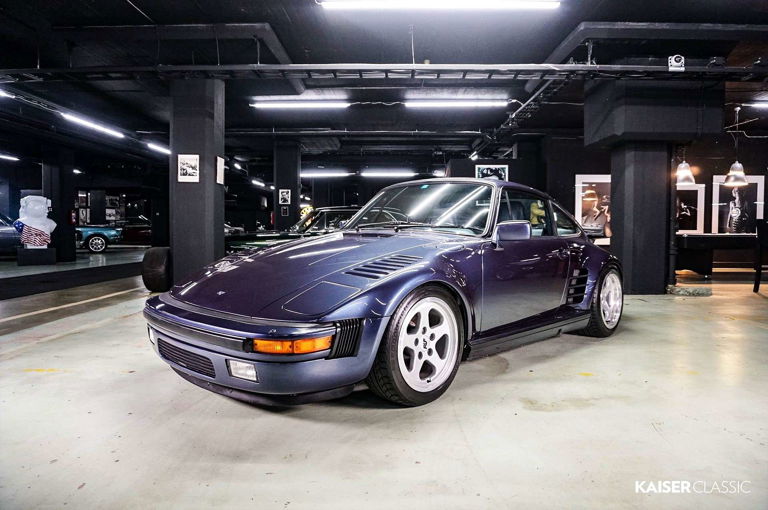As depicted in period photographs on file, this Turbo R Cabriolet was built in 2007 using a new, unused Porsche 993 Carrera 4 Cabriolet body shell. RUF’s craftsmen subsequently replaced several body components including the rear fenders and rocker panels during the conversion to “widebody” appearance. Mechanically, this Turbo R received bespoke chassis engineering and tuning – as it was the only Cabriolet built – while a 3.6-liter, twin-turbocharged 490 hp engine mated to a six-speed manual transmission sending power to all four wheels was installed.
Finished in the vibrant Porsche color of Tangerine (POR 18) over a contrasting black leather interior with complementary stitching in body color and a black convertible top, this Turbo R Cabriolet also features deeply bolstered Recaro sport seats, RUF aluminum pedals, and a Becker radio. Displaying 10,223 miles at the time of cataloguing, this Turbo R displays in commensurately immaculate condition inside and out, and is accompanied by books, tools, jack, spare tire, and original RUF Zertifikat.
During the 964- and 993-generation, Porsche offered few options for enthusiasts who desired maximum performance and an open-air experience outside of its “Special Wishes” department. In fact, Porsche’s own limited-production 993 Turbo Cabriolet featured two-wheel drive and a single turbocharged engine, unlike this RUF Turbo R Cabriolet, which boasts four-wheel drive and a twin-turbo powerplant.
Worthy of any collector’s closest scrutiny, this one-of-one Turbo R Cabriolet is but one example of how RUF stepped in to fill the void, building machines Porsche would not, and elevating an already great car in the process.
Located three hours east of Stuttgart, RUF Automobile GmbH was founded in 1939 by Alois Ruf Sr. as a general service and automotive repair workshop. Following his father’s passing in 1974, Alois Ruf Jr. indulged his passion for the marque and refocused the company on modifying and building Porsche-based automobiles. In 1981, the German TÜV (Technical Inspection Association) granted RUF manufacturing status, recognizing it as an independent manufacturer, with similar acknowledgement from the US following in 1988.
RUF presented its own vision of the Porsche 993-generation Turbo in 1998. Starting with a “body in white” sourced from Porsche, RUF’s designers afforded their Turbo R a subtle new look via a RUF front facia with vents ahead of the front wheels, RUF-designed 18” five-spoke alloy wheels, and sport mirrors that were more aerodynamic than the regular items. Interior appointments included sport seats, RUF steering wheel, and RUF-branded VDO instrumentation with the company’s traditional green markings. Providing occupant protection while bolstering chassis rigidity, an optional roll cage was integrated into the car’s internal structure.
The Turbo R’s air-cooled 3.6-liter engine received enhancements over standard including modified KKK turbochargers, new camshafts, and a revised exhaust system. An additional oil cooler was positioned behind the front bumper, while the Bosch engine control unit (ECU) was optimized. Power increased from 408 hp at 5,750 rpm to 490 hp at a slightly lower 5,500 rpm, while torque grew from 398 lbs./ft. to 478 lbs./ft. at 4,800 rpm.
Firmer springs, altered shocks, and larger anti-roll bars were substituted to cope with increased power and the more sporting nature of the Turbo R. The Porsche Turbo’s six-speed transmission remained untouched apart from revised gear ratios, while brake discs were enlarged for more assured stops. According to RUF, the Turbo R required just 3.6 seconds for the sprint to 60 mph and claimed a top speed of 204 mph.

























